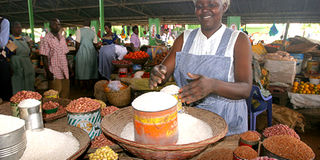World Bank sounds alert on food prices

The Food Price Watch says global food prices in July 2011 remain 33 per cent higher than a year ago.
What you need to know:
- Energy costs and the effects of drought and conflict are making life unpleasant in region
The price of maize in the Horn of Africa has doubled over the last year, the World Bank has said.
In Kenya, it has increased by 89 per cent, according to the bank’s Food Price Watch report. This is the fourth highest increase in the price of maize in the world behind Uganda (122 per cent), Somalia (107 per cent) and Rwanda (104 per cent).
Overall, the Food Price Watch says global food prices in July 2011 remain 33 per cent higher than a year ago.
Globally, maize (up 84 per cent), sugar (up 62 per cent), wheat (up 55 per cent) and soybean oil (up 47 per cent) contributed most to the increase.
While the Horn of Africa emergency was triggered by droughts, especially in areas struggling with conflict and internal displacement such as Somalia, food prices that are near record high levels seen in 2008 also contributed to the situation, the report said.
The combination of drought, conflict and soaring food prices has had a deadly effect on the region’s most vulnerable children and families.
“The availability of grains in specific areas of Kenya, Ethiopia, and Somalia is very low, and coupled with export restrictions imposed by Ethiopia and Tanzania, has contributed to price rises in the region,” it said.
Severest drought
More than 12 million people in the Horn of Africa are in need of food aid. Of these, nearly 4 million are Kenyans mainly in Rift Valley, North Eastern and Eastern parts of the country.
Eastern Province leads with those facing severest drought standing at nearly 800,000, while Rift Valley has 581,848 and North Eastern 477,957.
The vulnerable populations are concentrated in the counties of Wajir, Kitui, Turkana, Makueni, Garissa, Kwale, Mandera, Marsabit, Kilifi, Samburu and Kajiado.
Also in need of help are 19,751 internally displaced persons.
The situation in the country has not been helped by the influx of refugees from Somalia flooding the Dadaab camp. It is estimated that there are 400,000 Somali refugees in the 90,000-capacity camp.
The UN has declared the drought in the Horn of Africa the worst in 60 years and the refugee situation as the worst humanitarian crisis.
Over the last three months, 29,000 children under the age of five have died in Somalia, while another 600,000 in the region are at risk.
“Nowhere are high food prices, poverty and instability combining to produce tragic suffering more than in the Horn of Africa,” said World Bank president Robert Zoellick.
“The World Bank is stepping up with short-term help through safety nets to the poor and the vulnerable in places like Kenya and Ethiopia, along with medium term support for economic recovery. Long-term support is also critical to build drought resilience and implement climate-smart farming.”
The World Bank Group is providing Sh62.7 billion ($686 million) to save lives, improve social protection, and foster economic recovery and drought resilience for people in the Horn of Africa.
Initially, the Bank will target the most vulnerable by enhancing safety nets.
Sense of urgency
“We are stepping up to address this crisis with a sense of urgency,” said Mr Zoellick, who has been advocating for the G20 to put food first since the beginning of this year.
The report says cereal prices have significantly exceeded their previous year levels and reached record levels in Kenya, Ethiopia and Somalia.
Special Programmes minister Esther Murugi said last week the government had so far released Sh10.985 billion, which had been distributed through several departments active on the ground.
In addition, Kenyans for Kenya, an initiative of the corporate sector has raised close to Sh700 million for emergency relief.



